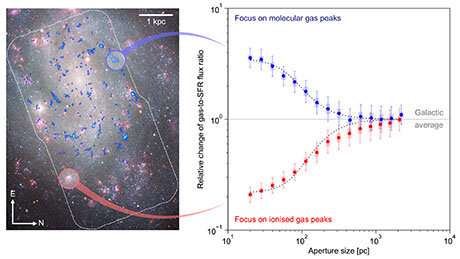Galaxies as 'cosmic cauldrons'

Star formation within interstellar clouds of gas and dust, so-called molecular clouds, proceeds very rapidly yet highly inefficiently. Most of the gas is dispersed by stellar radiation, revealing galaxies to be highly dynamic systems, like "cosmic cauldrons," consisting of components that constantly change their appearance. Based on new observations of the NGC 300 spiral galaxy, a team of scientists led by astrophysicist Dr. Diederik Kruijssen from Heidelberg University has now managed for the first time to reconstruct the time-evolution of molecular clouds and the star formation process within them. Their analysis shows that these clouds are short-lived structures undergoing rapid lifecycles, driven by the intense radiation from the new-born stars. The findings are published in Nature.
The observed intensity of star formation in the NGC 300 spiral galaxy can be explained in two ways. Molecular clouds may be very long-lived and eventually convert all of their mass into stars. In this case, the positions of young stars should generally match those of the molecular clouds from which they formed. Alternatively, stars may form very rapidly within molecular clouds and disperse the gas with their intense radiation, leaving only a small fraction of the gas available for conversion into stars. In this case, young stars and molecular clouds should generally reside in different locations.
To decide which of these models of the molecular cloud lifecycle is correct, Dr. Kruijssen and his team combined two different sets of observations of the NGC 300 galaxy, which is about 6 million light years away from the Milky Way. The first observation is a map of light emitted by carbon monoxide which shows where molecular clouds reside. The second is a map of hot, ionized hydrogen which marks the positions of massive, newly formed stars. These maps were obtained using the Atacama Large Millimeter Array (ALMA) of the European Southern Observatory (ESO) and the 2.2-meter telescope of the Max Planck Society and ESO. The ALMA observations were carried out by Dr. Andreas Schruba, scientist at the Max Planck Institute for Extraterrestrial Physics in Garching and one of the co-authors of the study. The scientists analyzed the data using a new statistical method that determines how molecular gas and star formation in galaxies are related on different spatial scales. For the first time, this method enables the precise quantification of the positions of molecular clouds and young stars relative to one another.
According to the scientists, the results left no doubt: The positions of molecular clouds and young, massive stars rarely coincide. This effect becomes stronger on smaller scales. The scientists conclude that stars form very rapidly, such that gas and young stars represent distinct, subsequent phases in the lifecycle of molecular clouds.
"Our findings demonstrate that star formation proceeds very rapidly and highly inefficiently," says Dr. Kruijssen, research group leader at the Institute for Astronomical Computing. "Molecular clouds in NGC 300 live for about ten million years and take only about 1.5 million years to be destroyed, well before the most massive stars have reached the end of their lives and explode as supernovae." Dr. Mélanie Chevance, a researcher in his team and also co-author of the paper, adds: "The intense radiation from young stars disperses their parent molecular cloud by heating it and dispersing it in the form of hot interstellar gas bubbles. This way, only two to three percent of the mass in molecular clouds is actually converted into stars."
The team of researchers now wants to apply their new statistical method to observations of very distant galaxies to infer how star formation in molecular clouds proceeded across the history of the Universe. "We will now proceed to investigate the relation between molecular clouds and young stars in galaxies throughout the cosmos. In the near future, this will allow us to understand galaxies as collections of components that undergo star formation-driven lifecycles and together shape the appearance of their host galaxies," explains Dr. Kruijssen.
More information: J. M. Diederik Kruijssen et al, Fast and inefficient star formation due to short-lived molecular clouds and rapid feedback, Nature (2019). DOI: 10.1038/s41586-019-1194-3
Journal information: Nature
Provided by Heidelberg University




















